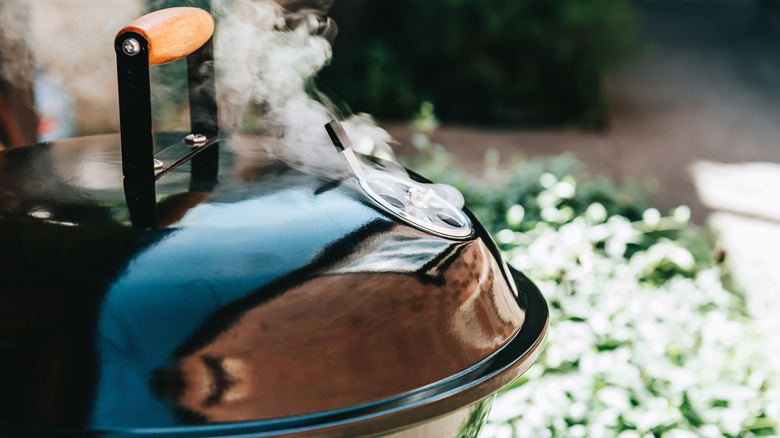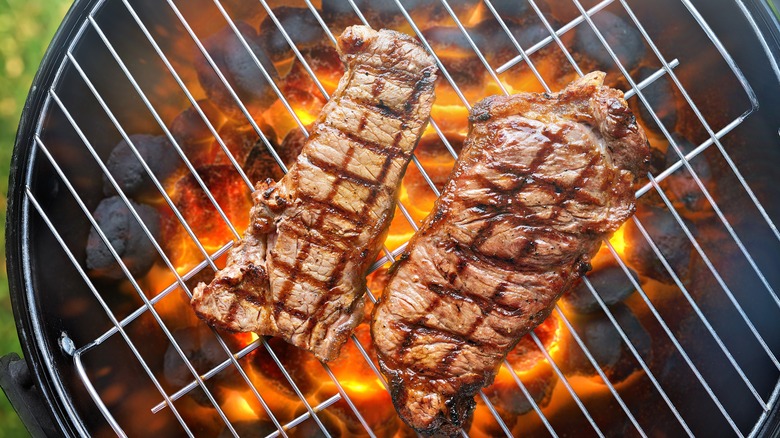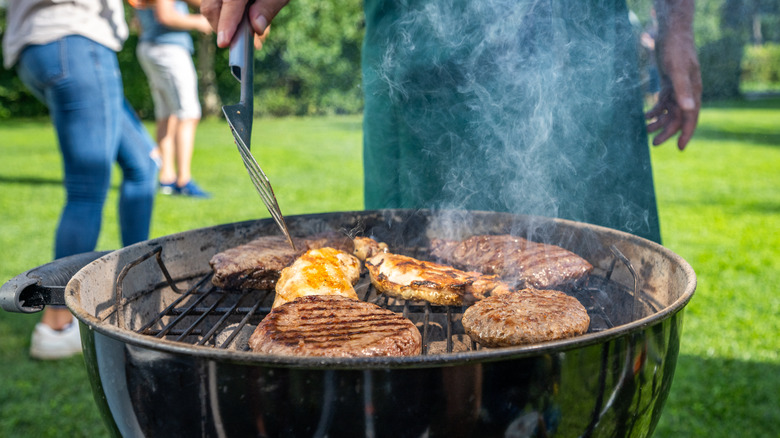Properly Position Your Grill Vents To Ensure The Best Cook For Your Meat
Grilling doesn't have to be complicated, and knowing how to control the temperature on your grill is the key to ensuring the best-cooked and tastiest meat possible. To do this, it's important to understand how to adjust your grill's air vents as you cook your meat. Adjustable vents, found on charcoal grills and wood smokers, are critical for controlling the grill's temperature, which should be monitored to avoid over or undercooking your meat.
Charcoal grills use oxygen and charcoal briquettes or lump charcoal for fuel. On a typical kettle charcoal grill, you'll find two air vents, one on the top and one on the bottom. The bottom vent is the intake damper, where oxygen is pulled into the grill to increase the heat, while the top vent acts as the exhaust damper, allowing smoke to escape and (when open) helping the intake damper to pull air into the grill. Although charcoal and wood grills are considered more difficult to control than gas grills, they can deliver much hotter temperatures (better for searing) and a tasty, smoky flavor that you won't get with a gas grill. In fact, a charcoal grill may be your best bet for steak. If you learn how to work the air vents, you'll prevent those flare-ups that charcoal grills are known for.
Different meats require different vent positions
Every grill master has a method they swear by, but there's no debate that adjusting your air vents is crucial for controlling the temperature of your charcoal grill. You can keep adding more charcoal to your grill, but if you don't have the vents open, you won't have any oxygen to fuel the fire. Remember, more air equals hotter fire, less air equals cooler temperature, and no air extinguishes the flames. Some foods require hotter temperatures to cook properly and to achieve the perfect sear.
Weber, a leading manufacturer of charcoal kettle grills, suggests beginners leave both vents fully open, while more seasoned grillers can leave the bottom vent fully open and control the temperature with the top vent. Their recommended instructions for adjusting the lid vent are cooking rotisserie foods like whole chickens or large roasts with it fully open (high heat), poultry with it half open (medium heat), sausages, fish, and smoked meat with it a quarter of the way open (low heat), and pulled pork, spare ribs, and brisket with it just slightly open (low and slow cooking). Keep in mind that you may have to adjust the vents depending on whether it is cold or windy outside. Also, if you haven't cleaned your grill in a while and too much ash accumulates, the bottom vents will be blocked so air won't be pulled through (which means your coals won't stay lit).
Other opinions and tips for charcoal grilling
Eventually, you'll figure out your preferred method, but getting tips from more experienced grillers is helpful for beginners. When it comes to airflow, not everyone agrees with only adjusting the lid vent. Some Redditors on the WeberGrills subreddit offer different advice. One said, "Adjust with the bottom vents only. That regulates the air intake. The top vent is the exhaust. Yes, closing the top vent some will also cool it down, but it also traps the smoke in there, and contrary to what some say, that is not what you want." However, other grillers on the post suggest setting the bottom vent before grilling and leaving it since it's difficult to reach and you risk getting ash on your food if it's adjusted during cooking. Another person says they only adjust the vents when doing a slow cook, otherwise they leave them both fully open and "create a hot zone and cool zone with the coals."
The amount of charcoal you use is another way to regulate the temperature of your grill. More charcoal is needed for cooking at higher temperatures and on windy or cold days. There are also different ways to arrange your coals, depending on what you're cooking. Foods that cook quickly, like steak, hamburgers, and hot dogs, can be cooked over direct heat (over the lit coals). When slow cooking or smoking large cuts of meat, it's best to cook over indirect heat (not directly over the coals).


